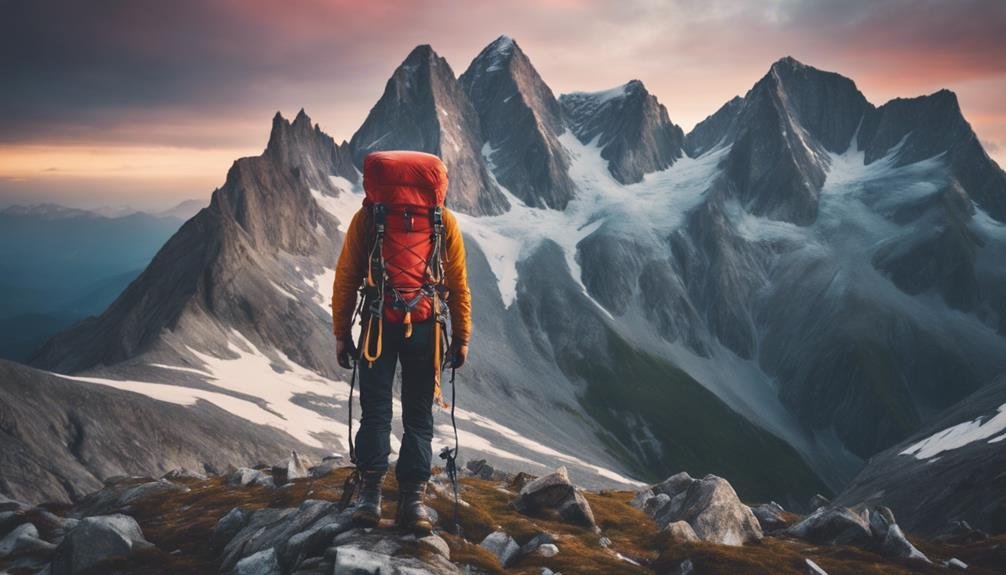
When preparing for my summit, I focus on essential gear that ensures a safe and successful ascent. I start with moisture-wicking base layers, insulating mid-layers, and a waterproof outer shell. My footwear features Vibram soles for traction and waterproof materials to keep my feet dry. I carry detailed maps and a compass for navigation, alongside safety gear like a helmet, ice axe, and avalanche transceiver. Hydration packs and emergency kits are crucial, too. Efficient cooking supplies, quality sleeping gear, and reliable climbing equipment round out my pack. There's so much more to consider, and I'll share the finer points next.
Key Takeaways
- Invest in a moisture-wicking base layer and insulating mid-layer for optimal temperature regulation during varying weather conditions.
- Choose footwear with Vibram soles for traction, waterproof materials for dryness, and padded ankle collars for support on rocky terrain.
- Equip yourself with navigation tools like detailed topographic maps and a compass for accurate route planning and orienteering.
- Carry essential safety gear, including an avalanche transceiver, climbing harness, helmet, and ice axe for protection on challenging climbs.
Essential Clothing Layers

When I prepare for a mountaineering adventure, I prioritize layering my clothing to effectively manage temperature and moisture.
The base layer is crucial; I always choose moisture-wicking fabrics that help pull sweat away from my skin. This keeps me dry and comfortable, especially during strenuous climbs. I prefer lightweight synthetic materials or merino wool, which also have natural antimicrobial properties, reducing odor on long treks.
Next, I add a mid-layer for thermal insulation properties. Fleece or down jackets work wonders here, trapping body heat while remaining breathable. I often opt for a zip-up fleece that I can easily adjust based on the weather.
Finally, my outer layer must be windproof and waterproof. A durable shell jacket protects me from the elements while ensuring breathability to prevent overheating. I always check for features like adjustable hoods and cuffs that offer additional protection without sacrificing mobility.
With the right combination of these essential clothing layers, I feel free to tackle any mountain challenge, confident that I can adapt to whatever conditions I encounter. Freedom in the mountains comes from being prepared, and layering is the key.
Footwear for Rocky Terrain
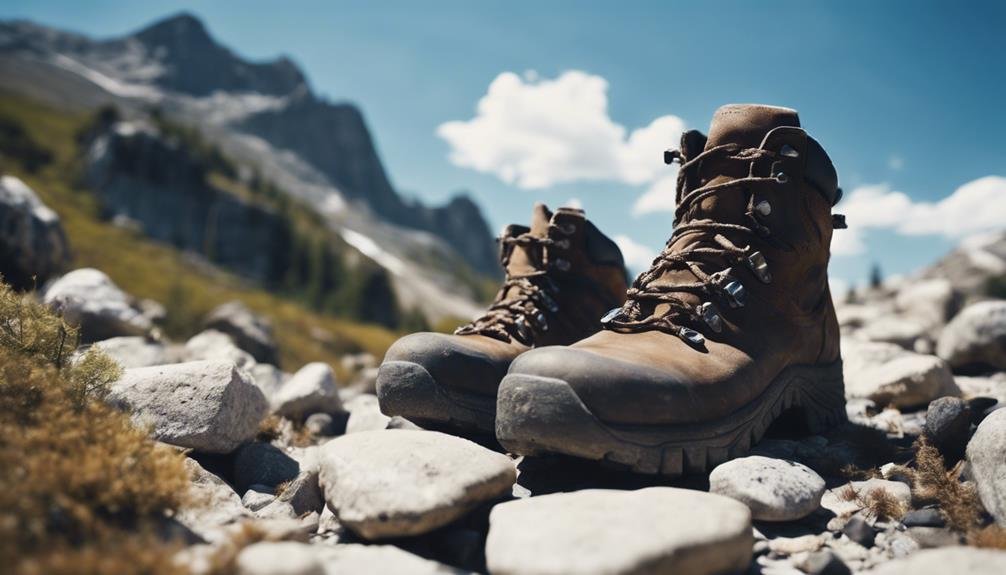
Choosing the right footwear for rocky terrain is essential for maintaining stability, comfort, and safety during my climbs. I've learned through experience that not all hiking boots are created equal. The right pair must offer excellent traction control features and robust ankle support systems. These elements help me navigate unpredictable surfaces and rocky outcrops without losing my footing.
The key features I look for in my mountaineering footwear include:
- Vibram soles for superior grip on uneven surfaces.
- Waterproof materials to keep my feet dry in wet conditions.
- Lightweight construction to reduce fatigue on long hikes.
- Padded collars for added comfort around my ankles.
Investing in the right footwear not only enhances my performance but also boosts my confidence as I tackle challenging trails. The combination of traction control features and ankle support systems allows me to focus on the journey ahead, exploring new heights and embracing the freedom that comes with every climb. After all, the right gear makes all the difference in my adventures.
Navigation Tools and Maps

Having reliable navigation tools and maps is crucial for ensuring I stay on track during my mountaineering adventures. A solid topographic map tailored to the area I'm exploring helps me gain a visual understanding of the terrain, elevation changes, and potential hazards. I always carry a compass, as it's essential for precise navigation. Before heading out, I make sure to perform compass calibration to ensure accuracy. Even a slight error can lead me off course.
I also practice orienteering techniques, which involve using my map and compass together. I identify landmarks and plot my route, paying attention to the scale and contour lines on my map. These skills not only boost my confidence but also deepen my connection with the wild landscapes I traverse.
In this digital age, I often download offline maps on my smartphone, but I never rely solely on technology. Batteries can die, and signals can be weak in remote areas. By combining traditional navigation tools with modern technology, I equip myself to embrace the freedom of the mountains while remaining grounded in safety and awareness.
Safety Equipment Overview
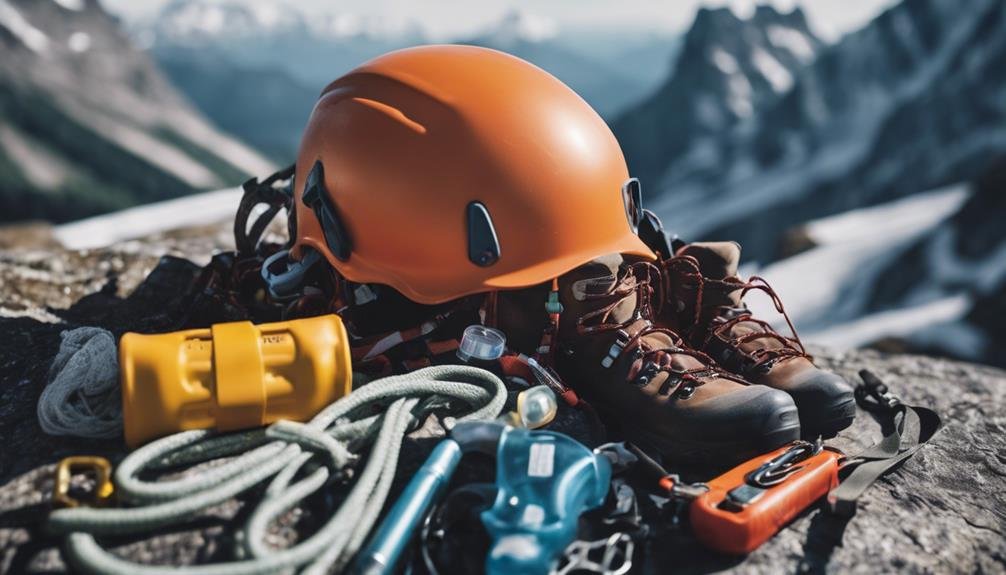
When I head out into the mountains, I always prioritize my safety gear. Essential items like helmets, harnesses, and first aid kits are crucial.
These tools not only protect me but also provide peace of mind, knowing I can reach help if needed.
I also make sure to carry emergency communication devices.
Essential Safety Gear
Safety gear is crucial for mountaineering, ensuring that I can navigate challenging terrains with confidence and reduce the risks associated with high-altitude adventures. When I gear up, I always prioritize my safety equipment, as it's my lifeline in unpredictable environments.
Avalanche transceiver: This device helps me locate fellow climbers in case of an avalanche, making it an essential safety tool.
Climbing harness: A reliable harness keeps me secure while ascending or descending steep slopes, allowing for greater mobility and safety.
Helmet: Protecting my head from falls and rock debris is vital, so I always wear a sturdy helmet.
Ice axe: This tool is indispensable for self-arresting during slips on icy terrain, giving me control over my descent.
Backcountry communication device: Staying connected with my team is essential, especially in remote areas where cell service is scarce.
Emergency Communication Devices
Emergency communication devices are vital tools that ensure I can reach out for help or coordinate with my team, especially in remote areas where traditional communication methods fail. When I'm out in the wild, I rely heavily on satellite communication devices. They allow me to send messages, check in with loved ones, or call for help even when I'm miles away from the nearest cell tower. These devices often come in compact, lightweight designs, making them easy to carry without weighing me down.
Another essential device I never venture without is a personal locator beacon (PLB). If I find myself in a dire situation, activating a PLB sends out a distress signal to rescuers, including my exact GPS coordinates. This feature is crucial in emergencies, as it significantly increases my chances of being located quickly.
Before heading out, I make sure my devices are fully charged and that I know how to operate them. Being prepared with reliable communication tools not only enhances my sense of freedom in the mountains but also ensures that I can handle unforeseen circumstances effectively.
Hydration Gear and Tips

When I'm out on the mountain, staying hydrated is crucial, and that's where hydration packs come in handy.
These packs allow me to carry water conveniently while keeping my hands free for climbing.
I also make sure to have effective water purification methods on hand, ensuring I can safely refill my supply from natural sources along the way.
Hydration Packs Overview
Hydration packs have become my go-to solution for staying hydrated on long hikes, offering a convenient way to carry water while keeping my hands free for climbing or navigating rugged terrain. With the right bladder design, these packs make drinking on the move effortless, allowing me to focus on the adventure ahead.
To maximize my hydration, I follow proper hydration techniques, like sipping small amounts regularly rather than gulping large quantities at once. This strategy not only keeps my energy levels up but also helps avoid stomach discomfort.
With a hydration pack, I embrace the freedom to explore, knowing I'm well-equipped to tackle any trail while staying refreshed along the way.
Essential features in a hydration pack:
- Comfortable straps: They distribute weight effectively to avoid fatigue.
- Insulated tubing: Keeps my water cool, especially on hot days.
- Easy-to-clean bladder: I can maintain proper hygiene and avoid nasty tastes.
- Multiple compartments: Perfect for stashing snacks, maps, or gear.
Water Purification Methods
Staying safe on the trail means knowing how to purify water, ensuring I've access to clean, drinkable sources wherever my adventures take me. I always carry a reliable water purification system since drinking untreated water can lead to serious illness.
Two popular methods I rely on are chemical water purifiers and gravity-based filtration systems.
Chemical water purifiers, like iodine or chlorine tablets, are lightweight and easy to use. I simply add a tablet to my water, wait for the recommended time, and I'm good to go.
However, I prefer gravity-based filtration systems for larger quantities. These setups are efficient, allowing me to filter multiple liters of water with little effort. I just fill the reservoir, hang it from a tree, and let gravity do the work.
Regardless of the method I choose, I always remember to pack a backup option. Staying hydrated is crucial, and having a reliable purification method means I can focus on the adventure without worrying about my water source.
With these tools in my kit, I'm ready to conquer any summit!
Cooking and Food Supplies
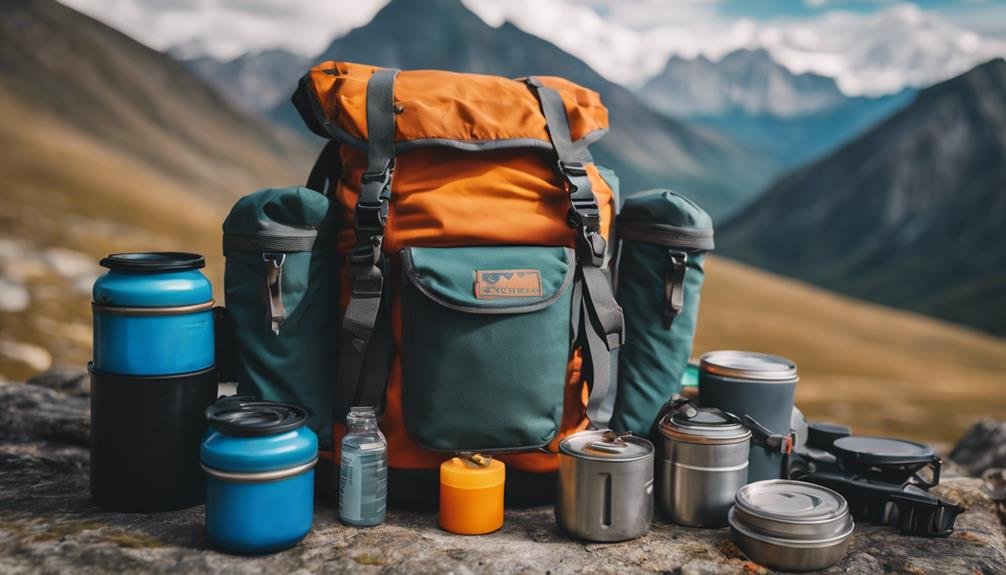
Packing the right cooking and food supplies is crucial for maintaining energy and morale during a mountaineering expedition. I always prioritize lightweight, nutritious options that can fuel my body through the toughest climbs.
A reliable camping stove is essential; it allows me to cook meals quickly and efficiently, even in the harshest conditions.
Energy dense foods: Nuts, dried fruits, and granola bars keep my energy levels high.
Freeze-dried meals: These are lightweight and only need hot water to prepare.
Cooking oil: A small bottle adds flavor and extra calories to my meals.
Spices and seasoning: They make a huge difference in morale, turning bland food into something enjoyable.
Lightweight cookware: A pot and a pan that fit easily into my pack ensure I can whip up meals without adding bulk.
Shelter and Sleeping Gear

After a long day of climbing and cooking, having a reliable shelter and sleeping gear makes all the difference in ensuring I get the rest I need to tackle the next day's challenges.
I always choose the right tent types based on the environment and duration of my trip. For shorter hikes, I prefer lightweight, three-season tents that offer a good balance between durability and packability. In harsher conditions, I opt for four-season tents that can withstand wind and snow.
When it comes to sleeping gear, I never compromise on a quality sleeping bag. I pay close attention to sleeping bag insulation—down or synthetic—depending on the weather. Down bags are excellent for colder temperatures and pack down small, but they lose insulation when wet. On the other hand, synthetic bags perform better in damp conditions, making them a safer bet for unpredictable weather.
I also bring a sleeping pad for insulation from the ground and added comfort. This combination of sturdy tents and efficient sleeping gear ensures I wake up refreshed and ready to chase my next adventure.
First Aid and Emergency Kits

Equipping myself with a well-stocked first aid and emergency kit is crucial for tackling the unpredictable nature of mountaineering. I know that accidents can happen, and being prepared can make all the difference. My kit isn't just a collection of items; it's my safety net in the wild.
- Antiseptic wipes: Perfect for cleaning wounds and preventing infections.
- Bandages: Essential for covering cuts and scrapes.
- Adhesive tape: Useful for securing bandages or splints.
- Pain relievers: I always pack some over-the-counter pain relief for headaches or muscle aches.
Every item in my kit has a purpose, and I make sure to check and restock it regularly. It's not just about the gear; it's about having peace of mind knowing I'm ready for whatever the mountain throws my way. With the right preparation, I can embrace the freedom of the climb, knowing I'm equipped to handle emergencies.
Climbing Gear Essentials
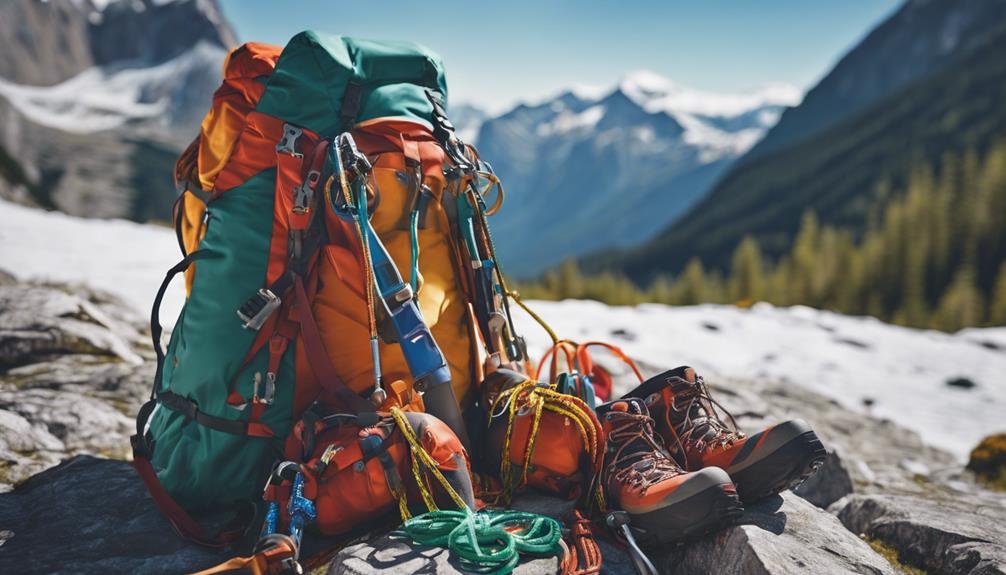
When I gear up for a climbing adventure, I focus on three key areas:
Essential climbing equipment, such as climbing shoes, a harness, and a belay device.
Safety gear must-haves, including a helmet, a sturdy carabiner, and a reliable rope.
Effective clothing layering techniques, choosing base layers, insulation, and outer shells to regulate body temperature.
Each piece of gear plays a crucial role in not only enhancing my performance but also ensuring my safety on the rock face.
Essential Climbing Equipment
Having the right climbing gear can make all the difference between a successful ascent and a dangerous situation on the mountain. I can't stress enough how crucial proper equipment is for both performance and safety. When I prepare for a climb, I focus on a few essential items that I know I can count on.
- Dynamic climbing rope: My rope selection is vital; it absorbs the impact during a fall.
- Harness: A well-fitted harness ensures comfort and security while I'm scaling heights.
- Carabiners: I always carry a mix of locking and non-locking carabiners for versatility.
- Climbing shoes: These give me the grip I need on challenging terrain, making every step count.
Regular equipment maintenance is key. I check my gear for wear and tear before each trip, ensuring everything's in top shape. This attention to detail not only boosts my confidence but also enhances my freedom to explore the mountains without hesitation.
Safety Gear Must-Haves
In mountaineering, prioritizing safety gear is essential for minimizing risks and ensuring a secure climbing experience. One of the first items I pack is a reliable helmet. It protects against falling rocks and other potential hazards.
Next, I never underestimate the importance of a harness. It keeps me securely attached to the rope and allows for safe ascents and descents.
When it comes to avalanche awareness, I make sure to carry a beacon, probe, and shovel. These tools are crucial for locating someone buried in snow—time is of the essence in these situations. Additionally, I always check the avalanche forecast before I head out, ensuring I'm aware of potential risks.
Extreme weather preparedness is also key. I choose a high-quality climbing rope, designed to withstand harsh conditions, and I bring a first-aid kit tailored to mountaineering needs. I also carry a multi-tool, which can handle everything from gear repairs to emergency situations.
Clothing Layering Techniques
Effective clothing layering techniques are crucial for maintaining body temperature and comfort during mountaineering adventures. The right combination of layers can make all the difference between an enjoyable climb and a miserable experience.
Moisture-wicking undergarment choices: I always start with a good base layer that pulls sweat away from my skin. Merino wool or synthetic fabrics work best.
Insulating midlayer garment selection: For my midlayer, I opt for fleece or down jackets to trap heat without adding bulk.
Weather-resistant outer layer: A breathable, waterproof shell is essential for protecting me from wind and rain.
Flexibility in layers: I prefer layers that I can easily add or remove, depending on the weather conditions.
Accessories: Don't forget hats, gloves, and neck gaiters, which can significantly impact warmth.
Packing and Weight Management
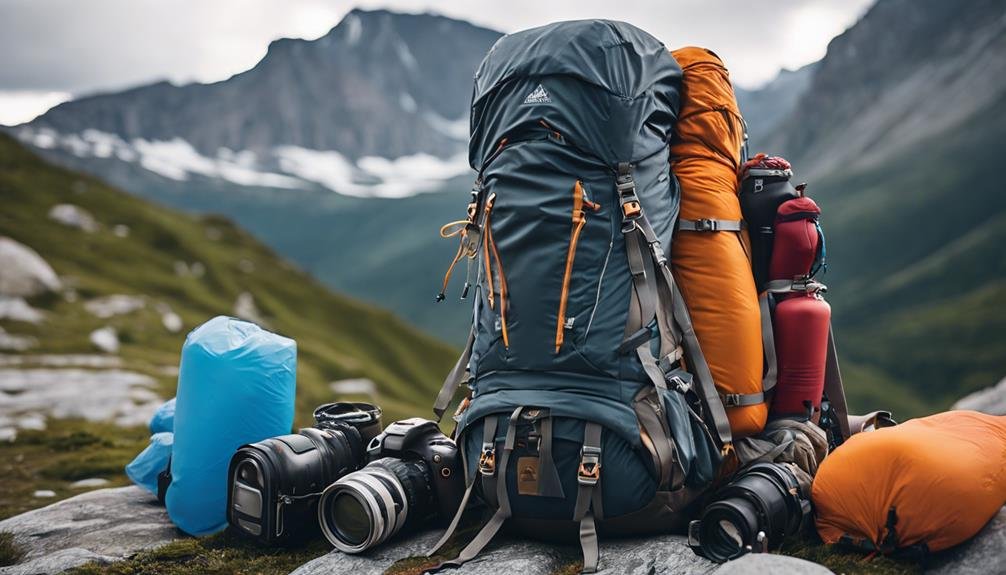
How can I ensure my pack is both lightweight and functional for a successful ascent? It all starts with smart pack organization and effective weight distribution. I focus on packing only what I truly need, which helps minimize unnecessary bulk. When I organize my gear, I consider how I'll access items during my climb.
Here's a simple packing guide that helps me visualize:
| Item Category | Placement in Pack |
|---|---|
| Sleeping Bag | Bottom of the pack |
| Clothes | Center for weight balance |
| Food & Cooking Gear | Top for easy access |
| Hydration System | Side pockets for balance |
| Emergency Gear | Easily accessible top pocket |
Conclusion
As I gear up for my next summit, I know that having the right equipment is half the battle won. From essential clothing layers to reliable navigation tools, every piece plays a vital role in my adventure.
It's crucial to pack wisely and prioritize safety to avoid any missteps along the way. Remember, it's better to be over-prepared than caught with your pants down.
With the right gear, I'm ready to tackle whatever the mountain throws my way.
